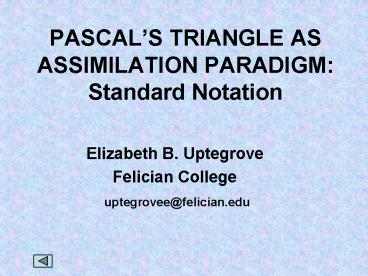PASCAL - PowerPoint PPT Presentation
1 / 40
Title:
PASCAL
Description:
Taxicab Problem ... First connect the taxicab problem to the towers problem in specific cases ... Romina Links the Taxicab Problem to '4 choose 3' and the ... – PowerPoint PPT presentation
Number of Views:79
Avg rating:3.0/5.0
Title: PASCAL
1
PASCALS TRIANGLE AS ASSIMILATION
PARADIGMStandard Notation
- Elizabeth B. Uptegrove
- Felician College
- uptegrovee_at_felician.edu
2
Background
- Students first investigated combinatorics tasks
- The towers problem
- The pizza problem
- The binomial coefficients
- Students then learned standard notation
3
Objectives
- Examine strategies that students used to
generalize their understanding of counting
problems - Examine strategies that students used to make
sense of the standard notation
4
Theoretical Framework
- Students should learn standard notation
- Having a repertoire of personal representations
can help - Revisiting problems helps students refine their
personal representations
5
Standard Notation
- A standard notation provides a common language
for communicating mathematically - Appropriate notation helps students recognize the
important features of a mathematical problem
6
Repertoires of Representations
- Existing representations are used to deal with
new mathematical ideas - But if existing representations are taxed by new
questions, students refine the representations - Representations become more symbolic as students
revisit problems - Representations become tools to deal with
reorganizing and expanding understanding
7
Research Questions
- How do students develop an understanding of
standard notation? - What is the role of personal representations?
8
Data Sources
- From long-term longitudinal study
- Videotapes of a group of 5 students
- Ankur, Brian, Jeff, Michael, and Romina
- After-school problem-solving sessions (high
school) - Individual task-based interviews (college)
- Student work
- Field notes
9
Methodology
- Summarize sessions
- Code for critical events
- Representations and notations
- Sense-making strategies
- Transcribe and verify
10
Combinatorics Problems
- Towers -- How many towers n cubes tall is it
possible to build when there are two colors of
cubes to choose from? - Pizzas -- How many pizzas is it possible to make
when there are n different toppings to choose
from?
11
Combinatorics Notation
- C(n,r) is the number of combinations of n things
taken r at a time - C(n,r) gives the number of towers n cubes tall
containing exactly r cubes of one color - C(n,r) gives the number of pizzas containing
exactly r toppings when there are n toppings to
choose from - C(n,r) gives the coefficient of the rth term of
the expansion of (ab)n - These numbers are found in Pascals Triangle
12
Students Strategies
- Early elementary Build towers and draw pictures
of pizzas - Later elementary Tree diagrams, letter codes,
organized lists - High school Tables and numerical codes binary
coding organization by cases
13
Results
- Students used their understanding of the pizza
and towers problems to make sense of
combinatorics notation and of the numbers in
Pascals Triangle - Students used this understanding to make sense of
a related combinatorics problem - Students regenerated or extended their work in
interviews two or three years later
14
Generating Pascals Identity
- First explain a particular row of Pascals
Triangle in terms of pizzas - Then explain a general row in terms of pizzas
- First explain the addition rule in specific cases
- Towers
- Pizzas
- Then explain the addition rule in the general case
15
Pascals Identity(Student Version)
- N choose X represents pizzas with X toppings when
there are N toppings to choose from - N choose X1 represents pizzas with X1 toppings
when there are N toppings to choose from - N1 choose X1 represents pizzas with X1
toppings when there are N1 toppings to choose
from
16
Pascals Identity(Student Explanation)
- To the pizzas that have X toppings (selecting
from N toppings), add the new topping - To the pizzas that have X1 toppings (selecting
from N toppings), do not add the new topping - This gives all the possible pizzas that have X1
toppings, when there are N1 toppings to choose
from
17
Taxicab Problem
- Find the number of shortest paths from the origin
(at the top left of a rectangular grid) to
various points on the grid - The only allowed moves are to the right and down
- C(n,r) gives the number of shortest paths from
the origin to a point n segments away, containing
exactly r moves to the right
18
Taxicab ProblemDiagram
19
Taxicab Problem(Student Strategies)
- First connect the taxicab problem to the towers
problem in specific cases - Then form the connection in the general case
- Finally, connect to the pizza problem
20
Romina Links the Taxicab Problem to 4 choose 3
and the Towers Problem
21
Brian and Romina Make Some Connections
22
Interview with Mike (2002)
23
Interview (Mike)
- Recall how to relate Pascals Triangle to pizzas
and standard notation - Call the row r and the position in the row n
- Write the equation
24
Pizzas on The Triangle
- The nth row is for the n-topping pizza problem
- The first number in each row is the no topping
pizza - The last number in each row in the all toppings
pizza - The rest of the numbers are for 1, 2, toppings
- Michael We see like the physical connection
25
Pizzas and Pascals Identity
26
Interview (Romina)
- She explained standard notation in terms of
towers, pizzas, and binary notation - She explained the addition rule in terms of
towers, pizzas, and binary notation - She explained the taxicab problem in terms of
towers
27
Romina Links Pizzas, Towers, and Binary Notation
28
Interview (Ankur)
- He explained standard notation in terms of towers
- He explained specific instance of the addition
rule in terms of towers - He explained the general addition rule in terms
of towers
29
Ankur Explains Pascals Identity in Terms of
Towers
30
Conclusions
- Students learned new mathematics by building on
familiar powerful representations - Students built up abstract concepts by working on
concrete problems - Students recognized the isomorphic relationship
among three problems with different surface
features - Their understanding appears durable
31
Questions?
32
The Towers Solution
- For each cube in the tower, there are two
choices blue or red - For a tower 4 cubes tall, the number of towers is
2?2?2?2 24 16 - For a tower n cubes tall, the number of towers is
2n.
33
The Pizza Solution
- There are two choices for each topping on or off
the pizza. When there are four toppings, there
are 2?2?2?2 24 16 possible pizzas - When there are n possible toppings, there are 2n
possible pizzas
34
Can You Explain theAddition Rule? (1998)
35
Can You Explain theAddition Rule? Yes!
36
Add a Blue to the Second 10
37
Pascals Triangle
38
(No Transcript)
39
(No Transcript)
40
Taxicab-Towers Isomorphism































